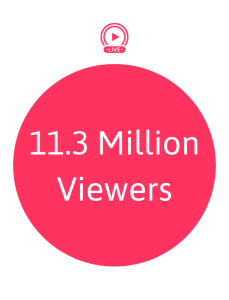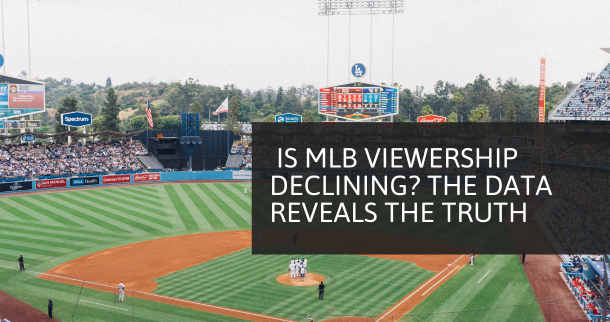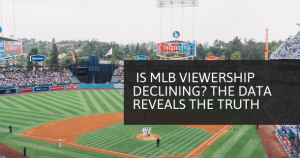Baseball has always been America’s pastime, but lately, I’ve been wondering if MLB viewership is truly declining or simply evolving. With digital streaming on the rise, shifting demographics, and growing competition from other sports, it’s important to examine how fans are consuming games today.
My goal in this study is to analyze MLB viewership trends over the past decade, including TV ratings, streaming numbers, and attendance patterns. I’ll also explore demographic shifts, the impact of rule changes, and how MLB compares to other major sports leagues.
To get a clearer picture, I’ll focus on four key questions:
| Key Research Questions |
|---|
| How have MLB TV ratings and streaming numbers changed over the past decade? |
| What demographic shifts are affecting MLB viewership? |
| How does MLB compare to other major sports leagues in terms of audience engagement? |
| What factors contribute to any observed decline or growth in viewership? |
Using industry reports, historical data, and expert analysis, I aim to understand whether baseball is losing relevance or adapting to new viewing habits.
This study will shed light on MLB’s future and potential strategies to keep fans engaged.
Historical Trends in MLB Viewership
Analyzing historical trends in Major League Baseball (MLB) viewership from 2015 to 2025 reveals a dynamic landscape influenced by various factors, including rule changes, media partnerships, and global events.
Television Viewership Trends

National Broadcasts: FOX’s regular-season MLB broadcasts experienced fluctuations over the decade. In 2015, the average viewership was approximately 2.2 million, which saw a decline to 1.88 million by 2023. However, a significant rebound occurred in 2024, with viewership rising to 2.4 million, likely due to high-profile matchups and increased fan engagement.

World Series Viewership: The World Series showcased varying audience numbers. The 2015 series averaged 14.53 million viewers, with a notable dip to 9.08 million in 2023. The 2024 World Series between the Los Angeles Dodgers and the New York Yankees reversed this trend, attracting 15.81 million viewers, underscoring the impact of marquee team matchups on audience interest.
Attendance Figures

Overall Attendance: MLB’s total attendance experienced a downward trend from 2015 (73.76 million) through 2019 (68.51 million). The COVID-19 pandemic in 2020 led to games without spectators, drastically impacting figures. Post-pandemic recovery began in 2021, and by 2024, attendance rebounded to 71.35 million, the highest since 2017.

Per-Game Attendance: Average attendance per game followed a similar pattern, decreasing from 30,517 in 2015 to 28,203 in 2019. The 2020 season saw no in-person attendance, but by 2024, the average climbed back to 29,373, reflecting renewed fan interest and successful engagement strategies.
Factors Contributing to Declining (or Growing) Viewership
MLB’s viewership faces multiple challenges: historically lengthy games have contributed to declining engagement, prompting rule changes like the pitch clock and extra-inning tweaks to shorten play.
Demographic shifts mean an aging fanbase and younger fans drawn to faster-paced sports; intense competition from the NFL, NBA, and esports further fragments audiences.
Shifting media rights and streaming deals have made access more complicated; and while modifications such as the universal DH, pitch clock, and larger bases have improved engagement, the long-term impact on overall viewership remains to be seen.
Comparison with Other Major Sports Leagues
Analyzing viewership data from 2015 to 2024 reveals distinct trends among Major League Baseball (MLB), the National Basketball Association (NBA), and the National Football League (NFL).
1. National Football League (NFL):
- Regular Season Viewership: The NFL consistently leads in viewership. In the 2023 season, games averaged 17.9 million viewers, a 7% increase from the previous season and the highest since 2015.

- Super Bowl Viewership: Super Bowl LVIII in 2024 set a record as the most-watched single telecast in U.S. history, attracting over 123 million viewers.

2. National Basketball Association (NBA):
- Regular Season Viewership: The 2023-2024 NBA regular season averaged 1.56 million viewers across ABC, ESPN, and TNT.

- NBA Finals Viewership: The 2024 NBA Finals between the Boston Celtics and the Dallas Mavericks averaged 11.3 million viewers in the U.S.

3. Major League Baseball (MLB):
- Regular Season Viewership: In 2024, MLB experienced a resurgence, with viewership increasing by nearly 20% compared to the previous year. thetimes.co.uk

- World Series Viewership: The 2024 World Series featuring the Los Angeles Dodgers and the New York Yankees averaged 14.3 million viewers, a significant rise from the 9.1 million viewers during the 2023 World Series. statista.com

Comparative Insights:
- Dominance of the NFL: The NFL maintains a substantial lead in viewership over both the NBA and MLB, with regular-season games and marquee events like the Super Bowl drawing significantly higher audiences.
- Fluctuations in NBA and MLB Viewership: Both the NBA and MLB have experienced periods of declining viewership, with notable rebounds in 2024. The NBA’s introduction of the mid-season Emirates Cup tournament initially boosted interest, but subsequent declines highlight challenges in sustaining audience engagement.
- Impact of High-Profile Matchups: For MLB, marquee matchups significantly influence viewership. The 2024 World Series between the Dodgers and Yankees, featuring star players like Shohei Ohtani and Aaron Judge, drew substantial audiences, underscoring the appeal of historic rivalries and star power.
In summary, while the NFL consistently outperforms both the NBA and MLB in viewership, strategic initiatives and high-profile matchups have enabled the NBA and MLB to achieve notable gains in 2024.
Future Outlook for MLB Viewership
Major League Baseball (MLB) is experiencing a resurgence in viewership and attendance, driven by strategic initiatives and evolving media landscapes.
1. Enhanced Fan Engagement and Attendance
- Attendance Growth: In 2024, MLB reported an average attendance of 28,805 per game, marking a nearly 1% increase from the previous year and sustaining a 9.6% rise since 2023. This growth is partly attributed to the successful implementation of the pitch clock, which has shortened game durations and made attending games more appealing, especially on weekdays.
- Youthful Demographics: The league has seen an 8.5% increase since 2019 in ticket buyers aged 18-35, with the median age of ticket purchasers dropping from 51 to 46. This shift indicates MLB’s successful efforts to attract a younger audience through initiatives like the PLAY BALL program and enhanced digital engagement.
2. Media Rights and Broadcasting Evolution
- Transition from Traditional RSNs: The financial instability of regional sports networks (RSNs) has prompted MLB to take control of local broadcasts for teams such as the Cleveland Guardians, Milwaukee Brewers, and Minnesota Twins starting in 2025. This move aims to expand market reach, increase viewership by millions of households per market, and eliminate blackouts, thereby enhancing accessibility for fans.
- National Broadcast Adjustments: The mutual decision by ESPN and MLB to conclude their media rights partnership after the 2025 season reflects the industry’s shift towards streaming platforms. MLB is exploring new partnerships with digital platforms to adapt to changing viewer habits and ensure broader accessibility.
3. International Expansion and Diverse Talent
- Global Viewership Increase: MLB’s international viewership rose by 18% in 2024, with significant growth in Asia (32%) and Latin America (16%). The presence of international stars, particularly from Japan, has bolstered MLB’s global appeal and viewership.
- International Series and Talent: The league’s commitment to hosting regular-season games abroad, such as the Tokyo Series, and the influx of international players have strengthened MLB’s global presence and diversified its talent pool.
Conclusion
MLB’s proactive measures, including game pace adjustments and targeted marketing, have effectively revitalized interest and participation in the sport.
These efforts have not only attracted a younger demographic but also re-engaged existing fans, positioning baseball for sustained growth in the evolving sports entertainment landscape.






